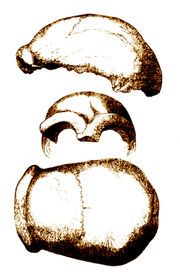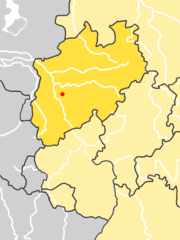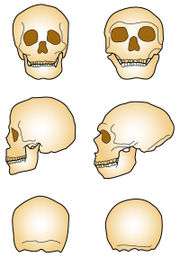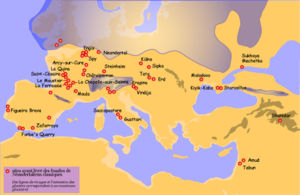Neanderthal
2008/9 Schools Wikipedia Selection. Related subjects: Ancient History, Classical History and Mythology
| Neanderthal Fossil range: Pleistocene |
||||||||||||||
|---|---|---|---|---|---|---|---|---|---|---|---|---|---|---|
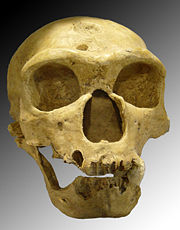 H. neanderthalensis La Chapelle-aux-Saints.
|
||||||||||||||
| Conservation status | ||||||||||||||
|
Fossil
|
||||||||||||||
| Scientific classification | ||||||||||||||
|
||||||||||||||
| Binomial name | ||||||||||||||
| †Homo neanderthalensis King, 1864 |
||||||||||||||
| Synonyms | ||||||||||||||
|
Palaeoanthropus neanderthalensis |
The Neanderthal (IPA: /niːˈændərθɔːl/, also with /neɪ-/, and /-tɑːl/), or Neandertal, was a species of the Homo genus (Homo neanderthalensis or Homo sapiens neanderthalensis) which inhabited Europe and parts of western and central Asia. The first proto-Neanderthal traits appeared in Europe as early as 350-500 thousand years ago. Complete Neanderthal characteristics had appeared 130,000 years ago and disappeared from Asia by 50,000 years ago and from Europe by 30,000 years ago. The latest skeletal remains with Neanderthal traits were found in Lagar Velho in Southern Iberia and dated to 24,500 years ago, and the latest traces of Neanderthal culture date to 30,000-24,000 years ago on the southernmost tip of the Iberian Peninsuala (in this period in Europe evolved Mousterian, Châtelperronian, Aurignacian and Gravettian archeological cultures). Neanderthal coexisted with modern humans up to 15,000 years after Homo sapiens had migrated into Europe from east or south. Steven L. Kuhn and Mary C. Stiner believed that the population of Neanderthals was never much more than 10,000 individuals.
Neanderthals had many adaptations to a cold climate: short, robust builds, and rather large noses — traits selected by evolution in cold climates. Their cranial capacity was larger than modern humans, indicating that their brains may have been larger. They were almost exclusively carnivorous and top predators. On average, the height of Neanderthals was comparable to contemporaneous homo sapiens. Neanderthal males stood about 165–168 cm tall (about 5'5")(found 1.9 m tall) and were heavily built with robust bone structure. They were much stronger, having particularly strong arms and hands. Females stood about 152–156 cm tall (about 5'1"). The characteristic style of stone tools in the Middle Paleolithic is called the Mousterian culture, after a prominent archaeological site where the tools were first found. The Mousterian culture is typified by the wide use of the Levallois technique. Mousterian tools were often produced using soft hammer percussion, with hammers made of materials like bones, antlers, and wood, rather than hard hammer percussion, using stone hammers. Near the end of the time of the Neanderthals, they created the Châtelperronian tool style, considered more advanced than that of the Mousterian. They either invented the Châtelperronian themselves or borrowed elements from the incoming modern humans who are thought to have created the Aurignacian.
Etymology and classification
The Neandertal is a small valley of the river Düssel in the German Federal State of North Rhine-Westphalia, located about 12 km (7.5 mi) west of Düsseldorf, the capital city of North Rhine-Westphalia. Neanderthal is now spelled two ways: the old spelling of the German word Thal, meaning " valley or dale", was changed to Tal in 1901, but the former spelling is often retained in English and always in scientific names, while the modern spelling is used in German while referring to the valley itself.
The Neander Valley was named after theologian Joachim Neander, who lived nearby in Düsseldorf in the late seventeenth century. In turn, Neanderthals were named after "Neander Valley", where the first Neanderthal remains were found. The term Neanderthal Man was coined in 1863 by Anglo-Irish geologist William King.
The original German pronunciation (regardless of spelling) is with the sound /t/. (See German phonology.) In American English the term is commonly anglicised to /θ/ (th as in thin), though scientists frequently use /t/. "Neander" is a classicized form of the common German surname Neumann.
For some time, professionals debated whether Neanderthals should be classified as Homo neanderthalensis or as Homo sapiens neanderthalensis, the latter placing Neanderthals as a subspecies of Homo sapiens. Genetic statistical calculation (2006 results) suggested that at least 5% of human modern gene pool can be attributed to ancient admixture, European contribution is the Neanderthal. Some morphological studies support that Homo neanderthalensis is a separate species and not a subspecies. Some suggests inherited addmixture. Others, for example University of Cambridge Professor Paul Mellars, say "no evidence has been found of cultural interaction" and evidence from mitochondrial DNA studies have been interpreted as evidence that Neanderthals were not a subspecies of H. sapiens. Homo sapiens mtDNA from Australia (Mungo Man 40ky ) is also not found in recent human genomic pool and mtDNA sequences for temporally comparative African specimens are not yet available.
Discovery
Neanderthal skulls were first discovered in Engis, Belgium (1829) and in Forbes' Quarry, Gibraltar (1848), both prior to the "original" discovery in a limestone quarry of the Neander Valley in Erkrath near Düsseldorf in August, 1856, three years before Charles Darwin's On the Origin of Species was published.
The type specimen, dubbed Neanderthal 1, consisted of a skull cap, two femora, three bones from the right arm, two from the left arm, part of the left ilium, fragments of a scapula, and ribs. The workers who recovered this material originally thought it to be the remains of a bear. They gave the material to amateur naturalist Johann Carl Fuhlrott, who turned the fossils over to anatomist Hermann Schaaffhausen. The discovery was jointly announced in 1857.
The original Neanderthal discovery is now considered the beginning of paleoanthropology. These and other discoveries led to the idea that these remains were from ancient Europeans who had played an important role in modern human origins. The bones of over 400 Neanderthals have been found since.
Notable fossils
- La Ferrassie 1: A fossilized skull discovered in La Ferrassie, France by R. Capitan in 1909. It is estimated to be 70,000 years old. Its characteristics include a large occipital bun, low-vaulted cranium and heavily worn teeth.
- Shanidar 1: Found in the Zagros Mountains in northern Iraq; a total of nine skeletons found believed to have lived in the Middle Paleolithic Period. One of the nine remains had an amputated arm. This is significant due to the fact that it shows that stone tools were present in that era. Also, another Neanderthal had been buried with flowers, showing that some type of burial ceremony may have occurred.
- La Chapelle-aux-Saints 1: Called the Old Man, a fossilized skull discovered in La Chapelle-aux-Saints, France by A. and J. Bouyssonie, and L. Bardon in 1908. Characteristics include a low vaulted cranium and large browridge typical of Neanderthals. Estimated to be about 60,000 years old, the specimen was severely arthritic and had lost all his teeth, with evidence of healing. For him to have lived on would have required that someone process his food for him, one of the earliest examples of Neanderthal altruism (similar to Shanidar I.)
- Le Moustier: A fossilized skull, discovered in 1909, at the archeological site in Peyzac-le-Moustier, Dordogne, France. The Mousterian tool culture is named after Le Moustier. The skull, estimated to be less than 45,000 years old, includes a large nasal cavity and a somewhat less developed brow ridge and occipital bun as might be expected in a juvenile.
- Neanderthal 1: Initial Neanderthal specimen found during an archaeology dig in August 1856. Discovered in a limestone quarry at the Feldhofer grotto in Neanderthal, Germany. The find consisted of a skull cap, two femora, the three right arm bones, two of the left arm bones, ilium, and fragments of a scapula and ribs.
- Kebara 2
Chronology
Bones with Neanderthal traits in chronological order.
- 200 kya: Atapuerca, Pontnewydd Cave, Vértesszöllos, Ehringsdorf, Casal de'Pazzi, Biache, La Chaise, Montmaurin, Prince, Lazaret, Fontéchevade
- 135-45:Krapina, Saccopastore, Malarnaud, Altamura, Gánovce, Denisova, Okladnikov, Pech de l'Azé, Tabun, Kebara, Régourdou, Mt. Circeo, La Ferrassie, Combe Grenal, Erd, La Chapelle-aux Saints 1, Amud, Shanidar, Teshik-Tash, Feldhofer.
- 45-35 Le Moustier, La Quina, l'Horus, Hortus, Kulna, Šipka, Saint Césaire, Bacho Kiro, El Castillo, Bñnolas, Arcy-sur-Cure.
- < 35 Chătelperron, Pestera cu Oase 35k, Figueria Brava, Zafaraya , Mladeč 31k, Vindija (Vi208, Vi207 29,28k-32400), Velika Pećina, Lagar Velho 24.5.
Anatomy
Compared to modern humans, Neanderthals were similar in height but with more robust bodies, and had distinct morphological features, especially of the cranium, which gradually accumulated more derived aspects, particularly in certain relatively isolated geographic regions. Evidence suggests that they were much stronger than modern humans; their relatively robust stature is thought to be an adaptation to the cold climate of Europe during the Pleistocene epoch.
A 2007 study confirmed that some Neanderthals had red hair and pale skin colour; however, the mutation in the MC1R gene arose independently of the mutation which causes a similar pigmentation pattern in modern humans.
Distinguishing physical traits
The following is a list of physical traits which distinguish Neanderthals from modern humans; however, not all of them can be used to distinguish specific Neanderthal populations, from various geographic areas or periods of evolution, from other extinct humans. Also, many of these traits occasionally manifest in modern humans, particularly among certain ethnic groups. Nothing is known about the shape of soft parts such as eyes, ears, and lips of Neanderthals.
- Cranial
- Suprainiac fossa, a groove above the inion
- Occipital bun, a protuberance of the occipital bone which looks like a hair knot
- Projecting mid-face
- Low, flat, elongated skull
- A flat basicranium
- Supraorbital torus, a prominent, trabecular (spongy) browridge
- 1200-1750 cm³ skull capacity (10% greater than modern human average)
- Lack of a protruding chin (mental protuberance; although later specimens possess a slight protuberance)
- Crest on the mastoid process behind the ear opening
- No groove on canine teeth
- A retromolar space posterior to the third molar
- Bony projections on the sides of the nasal opening
- Distinctive shape of the bony labyrinth in the ear
- Larger mental foramen in mandible for facial blood supply
- Broad, projecting nose
- Sub-cranial
- Considerably more robust
- Large round finger tips
- Barrel-shaped rib cage
- Large kneecaps
- Long collar bones
- Short, bowed shoulder blades
- Thick, bowed shaft of the thigh bones
- Short shinbones and calf bones
- Long, gracile pelvic pubis (superior pubic ramus)
- Bowed Femur
Language
The idea that Neanderthals lacked complex language was widespread, despite concerns about the accuracy of reconstructions of the Neanderthal vocal tract, until 1983, when a Neanderthal hyoid bone was found at the Kebara Cave in Israel. The hyoid is a small bone which connects the musculature of the tongue and the larynx, and by bracing these structures against each other, allows a wider range of tongue and laryngeal movements than would otherwise be possible. The presence of this bone implies that speech was anatomically possible. The bone which was found is virtually identical to that of modern humans.
The morphology of the outer and middle ear of Neanderthal ancestors, Homo heidelbergensis, found in Spain, suggests they had an auditory sensitivity similar to modern humans and very different from chimpanzees. They were probably able to differentiate between many different sounds.
Neurological evidence for potential speech in neanderthalensis exists in the form of the hypoglossal canal. The canal of neanderthalensis is the same size or larger than in modern humans, which are significantly larger than the canal of australopithecines and modern chimpanzees. The canal carries the hypoglossal nerve, which controls the muscles of the tongue. This indicates that neanderthalensis had vocal capabilities similar to modern humans. A research team from the University of California, Berkeley, led by David DeGusta, suggests that the size of the hypoglossal canal is not an indicator of speech. His team's research, which shows no correlation between canal size and speech potential, shows there are a number of extant non-human primates and fossilized australopithecines which have equal or larger hypoglossal canal.
Another anatomical difference between Neanderthals and Modern humans is their lack of a mental protuberance (the point at the tip of the chin). This may be relevant to speech as the mentalis muscle, one of the muscles which move the lower lip, is attached to the tip of the chin. While some Neanderthal individuals do possess a mental protuberance, their chins never show the inverted T-shape of modern humans. In contrast, some Neanderthal individuals show inferior lateral mental tubercles (little bumps at the side of the chin).
A recent extraction of DNA from Neanderthal bones indicates that Neanderthals had the same version of the FOXP2 gene as modern humans. This gene is known to play a role in human language.
Steven Mithen (2006) proposes that the Neanderthals had an elaborate proto-linguistic system of communication which was more musical than modern human language, and which predated the separation of language and music into two separate modes of cognition.
Tools
Neanderthal and Middle Paleolithic archaeological sites show a smaller and different toolkit than those which have been found in Upper Paleolithic sites, which were perhaps occupied by modern humans which superseded them. Fossil evidence indicating who may have made the tools found in Early Upper Paleolithic sites is still missing.
Neanderthals are thought to have used tools of the Mousterian class, which were often produced using soft hammer percussion, with hammers made of materials like bones, antlers, and wood, rather than hard hammer percussion, using stone hammers. A result of this is that their bone industry was relatively simple. However, there is good evidence that they routinely constructed a variety of stone implements. Neanderthal ( Mousterian) tools most often consisted of sophisticated stone-flakes, task-specific hand axes, and spears. Many of these tools were very sharp. There is also good evidence that they used a lot of wood, objects which are unlikely to have been preserved until today.
Also, while they had weapons, whether they had implements which were used as projectile weapons is controversial. They had spears, made of long wooden shafts with spearheads firmly attached, but they are thought by some to have been thrusting spears. Still, a Levallois point embedded in a vertebra shows an angle of impact suggesting that it entered by a "parabolic trajectory" suggesting that it was the tip of a projectile. Moreover, a number of 400,000 year old wooden projectile spears were found at Schöningen in northern Germany. These are thought to have been made by the Neanderthal's ancestors, Homo erectus or Homo heidelbergensis. Generally, projectile weapons are more commonly associated with H. sapiens. The lack of projectile weaponry is an indication of different sustenance methods, rather than inferior technology or abilities. The situation is identical to that of native New Zealand Maori - modern Homo sapiens, who also rarely threw objects, but used spears and clubs instead.
Although much has been made of the Neanderthal's burial of their dead, their burials were less elaborate than those of anatomically modern humans. The interpretation of the Shanidar IV burials as including flowers, and therefore being a form of ritual burial, has been questioned. On the other hand, five of the six flower pollens found with Shanidar IV are known to have had 'traditional' medical uses, even among relatively recent 'modern' populations. In some cases Neanderthal burials include grave goods, such as bison and aurochs bones, tools, and the pigment ochre.
Neanderthals also performed many sophisticated tasks which are normally associated only with humans. For example, it is known that they controlled fire, constructed complex shelters, and skinned animals. A trap excavated at La Cotte de St Brelade in Jersey gives testament to their intelligence and success as hunters .
Particularly intriguing is a hollowed-out bear femur with holes which may have been deliberately bored into it. This bone was found in western Slovenia in 1995, near a Mousterian fireplace, but its significance is still a matter of dispute. Some paleoanthropologists have hypothesized that it was a flute, while others believe it was created by accident through the chomping action of another bear. See: Divje Babe.
Pendants and other jewelry showing traces of ochre dye and of deliberate grooving have also been found with later finds, particularly in France but whether or not they were created by Neaderthals or traded to them by Cro-Magnons is a matter of controversy.
Habitat and range
Early Neanderthals lived in the Last Glacial age for a span of about 100,000 years. Because of the damaging effects which the glacial period had on the Neanderthal sites, not much is known about the early species. Places where their remains are known include Portugal, France and Spain, as well as Britain , Germany, Czech Republic, Slovakia, Croatia, Greece and Israel.
Classic Neanderthal fossils have been found over a large area, from northern Germany to Israel and Mediterranean countries like Spain and Italy in the south and from England in the west to Uzbekistan in the east. This area probably was not occupied all at the same time; the northern border of their range in particular would have contracted frequently with the onset of cold periods. On the other hand, the northern border of their range as represented by fossils may not be the real northern border of the area they occupied, since Middle-Palaeolithic looking artifacts have been found even further north, up to 60° on the Russian plain. Recent evidence has extended the Neanderthal range by about 1,250 miles (2,010 km) east into southern Siberia's Altay Mountains.
Cannibalism or Ritual defleshing?
Neanderthals hunted large animals, such as the mammoth. Stone-tipped wooden spears were used for hunting and stone knives were used for butchering the animals. They are also believed to have gathered wild plants like their ancestors, Homo erectus. However, they are believed to have practiced ritual defleshing. This hypothesis has been represented after researchers found marks on Neanderthal bones similar to the bones of a dead deer eaten by Neanderthals.
Intentional burial and the inclusion of grave goods are the most typical representations of ritual behaviour in the Neanderthals and denote a developing ideology. However, another much debated and controversial manifestation of this ritual treatment of the dead comes from the evidence of cut-marks on the bone which has historically been viewed as evidence of ritual defleshing.
Neanderthal bones from various sites ( Combe-Grenal and Abri Moula in France, Krapina in Croatia and Grotta Guattari in Italy) have all been cited as bearing cut marks made by stone tools. However, results of technological tests reveal varied causes.
Re-evaluation of these marks using high-powered microscopes, comparisons to contemporary butchered animal remains and recent ethnographic cases of excarnation mortuary practises have shown that perhaps this was a case of ritual defleshing.
- At Grotta Guattari, the apparently purposefully widened base of the skull (for access to the brains) has been shown to be caused by carnivore action, with hyena tooth marks found on the skull and mandible.
- According to some studies, fragments of bones from Krapina show marks which are similar to those seen on bones from secondary burials at a Michigan ossuary (14th century AD) and are indicative of removing the flesh of a partially decomposed body.
- According to others, the marks on the bones found at Krapina are indicative of defleshing, although whether this was for nutritional or ritual purposes cannot be determined with certainty.
- Analysis of bones from Abri Moula in France does seem to suggest cannibalism was practiced here. Cut-marks are concentrated in places expected in the case of butchery, instead of defleshing. Additionally the treatment of the bones was similar to that of roe deer bones, assumed to be food remains, found in the same shelter.
The evidence indicating cannibalism would not distinguish Neanderthals from modern Homo sapiens. Ancient and existing Homo sapiens, including the Korowai, are known to have practiced cannibalism and/or mortuary defleshing.
Pathology
Within the west Asian and European record there are five broad groups of pathology or injury noted in Neanderthal skeletons.
Fractures
Neanderthals seemed to suffer a high frequency of fractures, especially common on the ribs ( Shanidar IV, La Chapelle-aux-Saints 1 ‘Old Man’), the femur ( La Ferrassie 1), fibulae (La Ferrassie 2 and Tabun 1), spine ( Kebara 2) and skull (Shanidar I, Krapina, Sala 1). These fractures are often healed and show little or no sign of infection, suggesting that injured individuals were cared for during times of incapacitation. The pattern of fractures, along with the absence of throwing weapons, suggests that they may have hunted by leaping onto their prey and stabbing or even wrestling it to the ground.
Trauma
Particularly related to fractures are cases of trauma seen on many skeletons of Neanderthals. These usually take the form of stab wounds, as seen on Shanidar III, whose lung was probably punctured by a stab wound to the chest between the 8th and 9th ribs. This may have been an intentional attack or merely a hunting accident; either way the man survived for some weeks after his injury before being killed by a rock fall in the Shanidar cave. Other signs of trauma include blows to the head (Shanidar I and IV, Krapina), all of which seemed to have healed, although traces of the scalp wounds are visible on the surface of the skulls.
Degenerative disease
Arthritis is particularly common in the older Neanderthal population, specifically targeting areas of articulation such as the ankle (Shanidar III), spine and hips (La Chapelle-aux-Saints ‘Old Man’), arms ( La Quina 5, Krapina, Feldhofer) knees, fingers and toes. This is closely related to degenerative joint disease, which can range from normal, use-related degeneration to painful, debilitating restriction of movement and deformity and is seen in varying degree in the Shanidar skeletons (I-IV).
Hypoplastic disease
Dental enamel hypoplasia is an indicator of stress during the development of teeth and records in the striations and grooves in the enamel periods of food scarcity, trauma or disease. A study of 669 Neanderthal dental crowns showed that 75% of individuals suffered some degree of hypoplasia and that nutritional deficiencies were the main cause of hypoplasia and eventual tooth loss. All particularly aged skeletons show evidence of hypoplasia and it is especially evident in the Old Man of La Chapelle-aux-Saints and La Ferrassie 1 teeth.
Infection
Evidence of infections on Neanderthal skeletons is usually visible in the form of lesions on the bone, which are created by systematic infection on areas closest to the bone. Shanidar I has evidence of the degenerative lesions as does La Ferrassie 1, whose lesions on both femora, tibiae and fibulae are indicative of a systemic infection or carcinoma (malignant tumour/cancer).
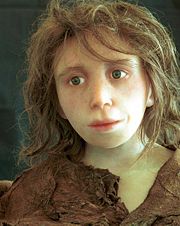
The fate of the Neanderthals
Possible hypotheses for the fate of Neanderthals include the following:
- Neanderthals evolved to a separate species which became extinct (see Neanderthal extinction hypotheses) and were replaced by early modern humans traveling from Africa.
- Neanderthals was a contemporary subspecies which incidentally bred with Homo sapiens and disappeared through absorption (see Neanderthal interaction with Cro-Magnons)
- Neanderthals never split from Homo sapiens and most of their populations transformed into anatomically modern humans between 50-30 kya (see Multiregional origin of modern humans).
According to the oldest view (#1), modern humans (Homo sapiens) began replacing Neanderthals around 45,000 years ago, as the Cro-Magnon people appeared in Europe, pushing populations of Neanderthals into regional pockets, where they held on for thousands of years, such as modern-day Croatia, Iberia, and the Crimean peninsula. The last traces of Neanderthal culture have been found around a cave system on the remote south-facing coast of Gibraltar, from 30,000 to 24,000 years ago.
The validity of such an extensive period of cornered Neanderthal groups is recently questioned. There is no longer certainty regarding the identity of the humans who produced the Aurignacian culture, even though the presumed westward spread of anatomically modern humans (AMHs) across Europe is still based on the controversial first dates of the Aurignacian. Currently, the oldest European anatomically modern Homo sapiens is represented by a robust modern human mandible discovered at Pestera cu Oase (south-west Romania), dated to 34–36 kya (thousand years ago). Human skeletal remains from the German site of Vogelherd, so far regarded the best association between anatomically modern Homo sapiens and Aurignacian culture, were revealed to represent intrusive Neolithic burials into the Aurignacian levels and subsequently all the key Vogelherd fossils are now dated to 3.9–5.0 thousand years ago instead. As for now, the expansion of the first anatomically modern humans into Europe can't be located by diagnostic and well-dated anatomically modern human fossils "west of the Iron Gates of the Danube" before 32 kya. Moreover, researchers have recently found in Pestera Muierii, Romania, remains of European humans from 30 kya who possessed mostly diagnostic "modern" anatomical features, but also had distinct Neanderthal features not present in ancestral modern humans in Africa, including a large bulge at the back of the skull, a more prominent projection around the elbow joint, and a narrow socket at the shoulder joint. Analysis of one skeleton's shoulder showed that these humans, like Neanderthal, did not have the full capability for throwing spears.
Consequently, the exact nature of biological and cultural interactions between Neanderthals and other human groups between 50 and 30 thousand years ago is currently hotly contested. A new proposal resolves the issue by taking the Gravettians rather than the Aurignacians as the anatomically modern humans which contributed to the post-30 kya Eurasian genetic pool. Correspondingly, the human skull fragment found at the Elbe River bank at Hahnöfersand near Hamburg was once radiocarbon dated to 36,000 years ago and seen as possible evidence for the intermixing of Neanderthals and anatomically modern humans. It is now dated to the more recent Mesolithic.
Modern human findings in Abrigo do Lagar Velho, Portugal of 24,500 years ago, allegedly featuring Neanderthal admixtures, have been published. The paleontological analysis of modern human emergence in Europe has been shifting from considerations of the Neanderthals to assessments of the biology and chronology of the earliest modern humans in western Eurasia. This focus, involving morphologically modern humans before 28,000 years ago shows accumulating evidence that they present a variable mosaic of derived modern human, archaic human, and Neanderthal features.
On the other hand, a mtDNA analysis has shown no evidence for Neanderthal contributions to the gene pool of modern humans. The authors of the study concede that this does not exclude Neanderthal contributions of other genes. They nevertheless argue that other genetic and morphological data also suggest little or no Neanderthal contribution. A study of Cro-Magnon mitochondrial DNA published in 2008 found that it was radically different that of almost contemporary Neanderthals.
Genome
While previous investigations concentrated on mitochondrial DNA (mtDNA) — which, due to strictly matrilineal inheritance and subsequent vulnerability to genetic drift, is of limited value to disprove interbreeding — more recent investigations have access to growing strings of deciphered nuclear DNA (nDNA).
In July 2006, the Max Planck Institute for Evolutionary Anthropology and 454 Life Sciences announced that they would be sequencing the Neanderthal genome over the next two years. The Neanderthal genome very likely is roughly the size of the human genome, three-billion base pairs, and probably shares most of its genes. It is thought that a comparison of the Neanderthal genome and human genome will expand understanding of Neanderthals as well as the evolution of humans and human brains.
DNA researcher Svante Pääbo has tested more than 70 Neanderthal specimens and found only one which had enough DNA to sample. Preliminary DNA sequencing from a 38,000-year-old bone fragment of a femur bone found at Vindija cave in Croatia in 1980 shows that Homo neanderthalensis and Homo sapiens share about 99.5% of their DNA. From mtDNA analysis estimates, the two species shared a common ancestor about 500,000 years ago. An article appearing in the journal Nature has calculated the species diverged about 516,000 years ago, whereas fossil records show a time of about 400,000 years ago. From DNA records, scientists hope to falsify or confirm the theory that there was interbreeding between the species. A 2007 study pushes the point of divergence back to around 800,000 years ago.
Edward Rubin of the Lawrence Berkeley National Laboratory in Berkeley, California states that recent genome testing of Neanderthals suggests human and Neanderthal DNA are some 99.5 percent to nearly 99.9 percent identical.
On November 16, 2006, Science Daily published scientific test results demonstrating that Neanderthals and ancient humans probably did not interbreed. Scientists with the U.S. Department of Energy’s Lawrence Berkeley National Laboratory (Berkeley Lab) and the Joint Genome Institute (JGI) sequenced genomic nuclear DNA (nDNA) from a fossilized Neanderthal femur. Their results more precisely indicate a common ancestor about 706,000 years ago, and a complete separation of the ancestors of the species about 376,000 years ago. Their results show that the genomes of modern humans and Neanderthals are at least 99.5% identical, but despite this genetic similarity, and despite the two species having cohabitated the same geographic region for thousands of years, there is no evidence of any significant crossbreeding between the two. Edward Rubin, director of both JGI and Berkeley Lab’s Genomics Division: “While unable to definitively conclude that interbreeding between the two species of humans did not occur, analysis of the nuclear DNA from the Neanderthal suggests the low likelihood of it having occurred at any appreciable level.”
On the other hand, a 2006 investigation suggested that at least 5% of the genetic material of modern Europeans and West Africans has an archaic origin, due to interbreeding with Neanderthal and a hitherto unknown archaic African population. Plagnol and Wall arrived at this result by first calculating a "null model" of genetic characteristics which would fulfill the requirement of descendence from Homo sapiens sapiens in a straight line. Next they compared this model to the current distribution and characteristics of existing genetic polymorphisms, and concluded that this "null model" deviated considerably from what would be expected. Genetic simulations indicated this 5% of DNA not accounted for by the null model corresponds to a substantial contribution to the European gene pool of up to 25%. Future investigation—including a full scale Neanderthal genome project—is expected to cast more light on the subject of genetic polymorphisms to supply more details. Contrary to the investigation of mtDNA, the study of polymorph mutations has the potential to answer the question whether—and to what extent—Homo neanderthalensis and Homo sapiens interbred.
A main proponent of the interbreeding hypothesis is Erik Trinkaus of Washington University. In a 2006 study published in Proceedings of the National Academy of Sciences, Trinkaus and his co-authors report a possibility that Neanderthals and humans did interbreed. The study claims to settle the extinction controversy; according to researchers, the human and neanderthal populations blended together through sexual reproduction. Trinkaus states, "Extinction through absorption is a common phenomenon." and "From my perspective, the replacement vs. continuity debate that raged through the 1990s is now dead".
There is a possibility that Neanderthals and Cro-Magnons interbred but left little genetic evidence of that. That is because there is an ongoing debate about whether the hunter-gatherers of the middle stone age started farming when they came in contact with agriculture, or were completely replaced by the farmers moving in from the Middle East. If modern Europeans are mainly descendents of these farming people with little or no genetic input of the hunter gatherers of the middle stone age, then possible interbreeding between them and the Neanderthals would not have had a great effect on the modern gene-pool.
The case for interbreeding recently revived by studies that claim signs of admixture ( introgression), finding unusually deep genealogies in highly divergent clades (genetic branches). The genetic variation at the microcephalin gene, a critical regulator of brain size whose loss-of-function by damaging mutations may also cause primary microcephaly, is claimed to be the most compelling evidence of admixture thus far. One type of the gene,dubbed haplogroup D having an exceptionally high worldwide frequency (~70%), was shown to have a remarkably young coalescence age to its most recent common ancestor ~37,000 years ago. The remaining types (non-D) coalesce to ~990,000 years ago, while the separation time between D and non-D was estimated at ~1,100,000 years ago. An evolutionary advance was assumed, even though positive selection was never as all-decisive as to wipe out the remaining 30% of non-D haplogroups (in which case no introgression could have been suggested) and as for now, a measurable genetic advance has not been attested. Both the worldwide frequency distribution of the D allele, exceptionally high outside of Africa but low in sub-Saharan Africa (29%) that suggests involvement of an archaic Eurasian population, and current estimates of the divergence time between modern humans and Neanderthals based on mitochondrial DNA (mtDNA), are in favour of the Neanderthal lineage as the most likely archaic Homo population from which introgression into the modern human gene pool took place.
Key dates
- 1829: Neanderthal skulls were discovered in Engis, Belgium.
- 1848: Skull of an ancient human was found in Forbes' Quarry, Gibraltar. Its significance was not realised at the time.
- 1856: Johann Karl Fuhlrott first recognised the fossil called “Neanderthal man”, discovered in Neanderthal, a valley near Mettmann in what is now North Rhine-Westphalia, Germany.
- 1880: The mandible of a Neanderthal child was found in a secure context and associated with cultural debris, including hearths, Mousterian tools, and bones of extinct animals.
- 1899: Hundreds of Neanderthal bones were described in stratigraphic position in association with cultural remains and extinct animal bones.
- 1908: A nearly complete Neanderthal skeleton was discovered in association with Mousterian tools and bones of extinct animals.
- 1953-1957: Ralph Solecki uncovered nine Neanderthal skeletons in Shanidar Cave in northern Iraq.
- 1975: Erik Trinkaus’s study of Neanderthal feet confirmed that they walked like modern humans.
- 1987: Thermoluminescence results from Palestine fossils date Neanderthals at Kebara to 60,000 BP and modern humans at Qafzeh to 90,000 BP. These dates were confirmed by Electron Spin Resonance (ESR) dates for Qafzeh (90,000 BP) and Es Skhul (80,000 BP).
- 1991: ESR dates showed that the Tabun Neanderthal was contemporaneous with modern humans from Skhul and Qafzeh.
- 1997 Matthias Krings et al. are the first to amplify Neanderthal mitochondrial DNA (mtDNA) using a specimen from Feldhofer grotto in the Neander valley. Their work is published in the journal Cell.
- 2000: Igor Ovchinnikov, Kirsten Liden, William Goodman et al. retrieved DNA from a Late Neanderthal (29,000 BP) infant from Mezmaikaya Cave in the Caucausus.
- 2005: The Max Planck Institute for Evolutionary Anthropology launched a project to reconstruct the Neanderthal genome.
- 2006: The Max Planck Institute for Evolutionary Anthropology announced that it planned to work with Connecticut-based 454 Life Sciences to reconstruct the Neanderthal genome.
Popular culture
In popular idiom the word neanderthal is sometimes used as an insult, to suggest that a person combines a deficiency of intelligence and an attachment to brute force, as well as perhaps implying the person is old fashioned or attached to outdated ideas, much in the same way as "dinosaur" is also used. Counterbalancing this are sympathetic literary portrayals of Neanderthals, as in the novel The Inheritors by William Golding, Isaac Asimov's The Ugly Little Boy, and Jean M. Auel's Earth's Children series, though Auel repeatedly compares Neanderthals to modern humans unfavorably within the series, showing them to be less advanced in nearly every facet of their lives. Instead she gives them access to a 'race memory' and uses it to explain both their cultural richness and eventual stagnation. A more serious treatment is offered by Finnish palaeontologist Björn Kurtén, in several works including Dance of the Tiger, and British psychologist Stan Gooch in his hybrid-origin theory of humans. The Neanderthal Parallax, a trilogy of science fiction novels dealing with neanderthals, written by Robert J. Sawyer, explores a scenario where neanderthals are seen as a distinct species from humans and survive in a parallel universe version of earth. The novels explore what happens when they, having developed a sophisticated technological culture of their own, open a portal to this version of the earth. The three novels are titled Hominids, Humans, and Hybrids, respectively, and all form essentially one story.
